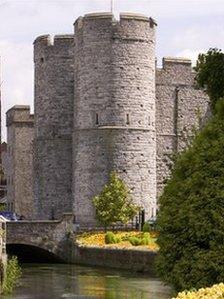Westgate Towers traffic ban continues after petition
- Published

Traffic has been banned from passing through the archway for 12 months
A ban on traffic passing through a medieval gateway in Canterbury will continue, after calls for it to end.
About 4,000 people signed a petition calling for the scheme to be scrapped, because of congestion, longer journey times and danger to pedestrians.
But Canterbury council's executive has agreed to continue the 12-month trial, which is to protect Westgate Towers.
Councillor Peter Vickery-Jones, cabinet transport member, said data for the whole year was needed.
He said problems had been caused by drivers breaking rules and they would be dealt with.
People had also complained about traffic being displaced on to back streets, he added. But he said: "Most of the traffic through the St Dunstan's area is going down Station Road West which was built particularly to do that."
Pet shop owner Dave Roberts said his business had seen a 20% downturn because of the scheme.
He said: "The perception of our customers is that they don't want to come into Canterbury, because the congestion delays them."
He added: "I don't think there's any question from anybody in the area that those towers need to be preserved, but I think that the way they are going about it could have been rethought."
Bob Jones, from the Canterbury City Partnership, said the issue was of "really serious concern". He added: "We can't underestimate the level of feeling that this trial has actually brought to the surface."
But he said the trial should continue so evidence could be analysed objectively.
Paul Bennett, from the Canterbury Archaeological Trust, said the archway, built in 1380, was the only surviving medieval gate to Canterbury and "one of the finest gates to any medieval city in the country".
He said the gateway was built by architect Henry Yevele who was working on the nave of Canterbury Cathedral at the time.
"It incorporated every device known to man for killing man, including some of the earliest gun loops recorded in the country," he said.
"So it had murder holes and machicolations and a drawbridge and portcullis. It had it all. But it was also a building imbued with civic pride."
- Published27 March 2012
- Published5 March 2012
- Published20 November 2011
- Published28 July 2011
- Published14 June 2010